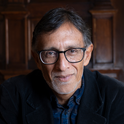As a child I had a horror of death. Lying in bed at night, I would contemplate my end. From the age of three or four there were two sources of night-time dread for me: the -vastness of the universe, and the inevitable annihilation of the self. “Imagine the end of the universe,” I would think. “Now, put a fence there. What’s on the other side of the fence?” And so on through the vastness of space. As for death, the thought process went like this: “each year you have lived is a quarter of your life. Next year it will be a fifth. And the year after, a sixth. Until, by the time you are twenty, and wearing high heels and cherry-red lipstick, you will be rattling downhill at speed.”
If lying in bed became impossible, I’d get up and walk down the hall to the living room, where my father would be reading. “I am afraid of death,” I would say, and he would reply, “so am I,” which somehow made it less awful. My father’s late-night reading was The Book of Common Prayer. Secure in his Enlightenment Judaism, he never thought himself in danger of conversion. Years later he remarked to one of his granddaughters: “you can teach yourself anything. You can even teach yourself not to be afraid of death.”
When I was 22 and in the high heels and cherry-red lipstick stage of life, I met and fell in love with the man who became my husband, the poet Geoffrey Hill. Just writing that, I see the mocking, exaggerated way he would have repeated the words “the poet.” And then he’d have added, “the word ‘poet’ has been so debased, I think we should replace it with something else. Like ‘Tharg’ (qv).”
Geoffrey was afraid of death, too. He was also frightened of hell, and wrote eloquently of these fears. Our life together filled the decades Geoffrey described as “playing in injury time” after he was first diagnosed with coronary artery disease. In Geoffrey’s last years, he would look out at the apple tree by his study window here, the ancient Beauty of Bath, and speculate which of them would go first. On the last evening of June 2016, I brought Geoffrey’s supper into the study and found him dead in his chair. His heart had simply stopped. He died without pain or dread.
Did I learn not to be afraid of death? Did being baptised take away the fear? What about being ordained? No, but I’ve learned to identify that fear in many of its forms: the outrage that wealth doesn’t confer immortality, the aversion to growing old, the revulsion at those who have suffered catastrophe, and so forth. The Church of England itself, as an institution, is afraid of death though it has been playing in injury time for several centuries. Each generation is determined that she won’t die on their watch. The resulting decades of evangelism, mission action plans, diocesan straplines and targets, each one more futile than the one before, create the impression that what we’re dealing with here is, in fact, the final stage of a Ponzi scheme.
This is the way that the Established Church expresses its fear of death and its doubts about resurrection. And this may be why, on the morning after Geoffrey’s death, one of our local bishops (this column isn’t complete without the appearance of a bishop) insisted on coming round to the Rectory to pray away any “malign spirits” that might have crept in when Geoffrey’s spirit departed his body. It was exactly like an old Punch cartoon in which a vacuum cleaner salesman gets his foot in the door and insists on emptying a bag of dirt on the carpet to demonstrate the superior sucking power of his machine. If there hadn’t been a friend present to witness all this, I wouldn’t have trusted myself to repeat the story.
Six years later, it seems to me on reflection that, whether in one human life or in the life of an institution, the fear of death is worse than the fact of mortality. Sure, the church is dying—and yet, day by day, week by week, it goes on, living and diffusing life and hope beyond its bounds. I am dying too: well past the high heels and cherry-red lipstick stage, more like Margot Heinemann in the years when Geoffrey would point her out to me whispering a little too loudly: “That’s Margot Heinemann! She was a great beauty once.” There never were malign spirits here. Only the presence of an all-powerful and all-loving God, and, for a few years, what sounded like someone walking into the bathroom upstairs and turning the taps on and off.













